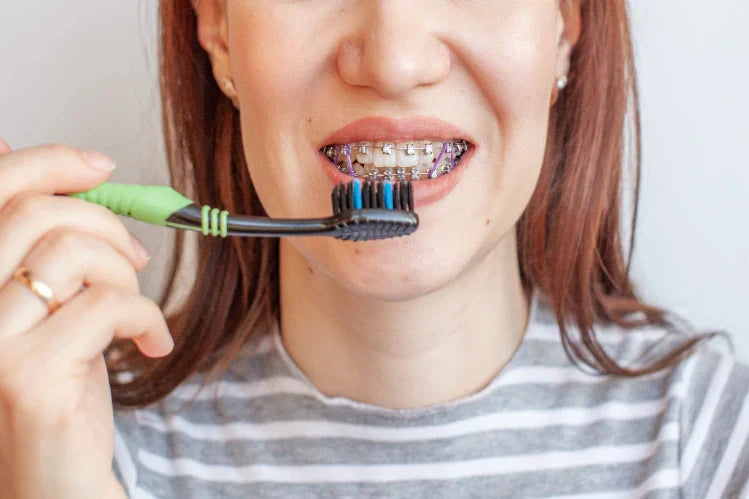
Table of contents
- How Often to Brush with Braces?
- Choosing the Best Toothbrush for Braces
- Step-by-Step: Brushing Techniques for Braces
- What If You Don’t Brush Properly?
- Bonus Dental Tips During Orthodontic Treatment
- The Quick Do’s and Don’ts of Dental Care During Orthodontic Treatment
- Thinking of a Simpler Option? Consider Clear Aligners
- Brushing with Braces
- FAQs
Starting orthodontic treatment is a big commitment, and one that pays off in the end by giving you a healthy and confident smile. However, after that initial dental appointment, it's easy to feel lost in braces. Simple and everyday things, like brushing your teeth, can suddenly feel stressful. And that’s where a common question strikes your mind: “Can you even brush your teeth normally with braces?”
The answer? Knowing the proper technique for brushing your teeth when you have braces is essential to maintain your dental health during the entire treatment.
Brushing your teeth with braces isn't just about making sure your breath smells okay; it's about ensuring that the results you get at the end of treatment are what you're supposed to get. In this blog, we will go through how to brush teeth with braces and what happens if you don’t do it properly.
How Often to Brush with Braces?
If you’ve eaten, it’s time to brush. It’s that simple.
- Minimum: Three times daily, morning, after lunch, and before bed
- Ideal: After every snack or meal
- Quick fix: Swish with water right after eating if you can’t get to your toothbrush
It may seem like too much at first, but it will become a habit, and your future self (and your smile) will be grateful.
Choosing the Best Toothbrush for Braces
Choosing the right toothbrush is crucial for maintaining oral hygiene with braces. It requires something that can reach those tight, awkward angles and still be gentle on your gums. Some qualities that you need to consider while getting yourself a toothbrush:
- Look for a soft bristle that gets into every corner but is gentle on the gums.
- For better results, get an electric toothbrush that vibrates to help dislodge stubborn plaque.
Step-by-Step: Brushing Techniques for Braces
Let’s simplify it into actionable steps:
Step 1: Swish and Scan
Start by rinsing your mouth with water. This simple act helps loosen any trapped food particles that might be lurking around your braces. After rinsing, take a moment to look in the mirror. This quick check allows you to identify any areas that need a little extra attention during your cleaning routine. Being proactive here sets the stage for a thorough clean.
Step 2: Angle It Right
To reach the maximum spaces, your toothbrush should be positioned at a 45-degree angle, while the bristles are directed over and under the brackets of your braces. Imagine your braces are tiny fences, and your goal is to clean all around them. This technique helps ensure that every corner is reached, optimizing your oral hygiene.
Step 3: Work the Brackets
Now that you’ve got your angle right, it’s time to get to work. Using small circular motions, focus on cleaning three key areas: above the wire, below the wire, and directly over each bracket. This methodical approach may take some time, but it’s well worth it for maintaining your oral health throughout your orthodontic treatment. Remember, consistency is key.
Step 4: Don’t Skip the Gumline
While focusing on your braces, don’t forget about your gums! Use gentle strokes along the gumline, the base of your teeth, where plaque can accumulate. Maintaining healthy gums is crucial for your overall oral health and plays a key role in ensuring your orthodontic treatment progresses without issues. A little extra care here can prevent discomfort and complications down the line.
Step 5: Clean Your Tongue and Chewing Surfaces
Bacteria have a way of hiding in unexpected places, so it’s essential to give your molars a good scrub, as well as your tongue. Use your toothbrush or a specialized tongue scraper to eliminate any buildup. This step is often overlooked, but it helps combat bad breath and keeps your mouth feeling fresh and clean.
Step 6: Rinse and Double-Check
After you feel satisfied with your brushing, rinse with water or fluoride mouthwash. This not only helps wash away any remaining debris but also adds an extra layer of protection against cavities. Finally, take a moment to inspect your teeth in the mirror. Are they sparkly clean? If you spot any missed areas, don’t hesitate to go back and rebrush. Ensuring a completely clean mouth will benefit you in the long run.
What If You Don’t Brush Properly?
We’re not trying to scare you… Okay, maybe just a little.
If you skip your brushing routine, here’s what could happen:
- White marks: These dull patches won’t vanish, even after your braces are off.
- Tooth decay: Trapped food becomes a buffet for bacteria.
- Swollen gums: Not just painful, but they can also delay your treatment progress.
- Stains: Discoloration that ruins your “big reveal” moment.
That’s a lot of risk for something that takes just a few minutes daily.
Bonus Dental Tips During Orthodontic Treatment
Want to level up your dental care game? Try these:
- Use an interdental or proxy brush for those hard-to-reach gaps.
- Water flossers are an absolute winner for flossing without frustration.
- Stick to alcohol-free fluoride rinses.
- Skip sticky or crunchy foods that can knock your brackets out of place.
- Don’t miss your dentist visits; those checkups matter.
The Quick Do’s and Don’ts of Dental Care During Orthodontic Treatment

These are some dos and don’ts of dental care during orthodontic treatment.
DOs
- Brush after every meal
- Use a soft or sonic toothbrush
- Floss daily using orthodontic-friendly tools
- Rinse with fluoride-based mouthwash
- Check your teeth in the mirror
DON’Ts
- Use hard-bristled brushes
- Rush through your brushing
- Eat chewy, sticky, or crunchy snacks
- Assume your teeth are clean without checking
- Skip dentist appointments
Thinking of a Simpler Option? Consider Clear Aligners

If you’re feeling overwhelmed by brushing with braces, you’re not alone. That’s why so many people are turning to aligners.
With clear aligners from Smilepath, you can:
- Remove them before meals, so there’s no trapped food. Enjoy your favorite foods without restrictions.
- Brush and floss like normal, and maintain your oral hygiene effortlessly.
- Enjoy a discreet, low-maintenance path to straighter teeth, and smile confidently without drawing attention to your treatment.
- Finish treatment faster, with no in-office visits.
- Customize your smile journey with a personalized treatment plan tailored to your needs.
- Benefit from advanced technology that allows for precise teeth movement and improved results.
- Experience comfort with a smooth, plastic design that won’t irritate your gums or cheeks.
- Track your progress with the Aligner Tracker app, keeping you motivated and informed along the way.
- Enjoy the convenience of at-home aligner delivery, minimizing disruption to your busy schedule.
- Discover the affordability of flexible payment plans that make achieving your dream smile accessible.
With Smilepath, achieving a beautiful smile has never been easier! For many, aligners offer a refreshing change: no brackets, no wires, no daily brushing battle.
Brushing with Braces
Brushing with braces requires extra effort, but the rewards are undeniable. Investing time in maintaining oral hygiene during orthodontic treatment pays off significantly. With the right techniques and tools, like an interdental toothbrush, the process becomes manageable.
Using dental aligners such as Smilepath aligners instead of braces can simplify oral hygiene during orthodontic treatment. You can easily remove Smilepath clear aligners to brush and floss, making cleaning straightforward without the hassle of brackets and wires. This convenience allows you to maintain your regular dental routine while working toward your dream smile effortlessly!
FAQs
Yes, but you’ll need to adjust your technique slightly to clean around brackets and wires thoroughly. Using gentle, circular motions and brushing at different angles helps ensure a proper cleaning.
Skipping flossing can lead to plaque buildup between teeth and under the wires, increasing the risk of cavities, gum inflammation, and bad breath.
While you can use a regular soft-bristle toothbrush, an electric or orthodontic-friendly brush is often more effective at reaching difficult areas around the braces.
Brushing gently with the right technique won’t loosen your braces. However, aggressive brushing or using a hard-bristle brush can damage wires or brackets.
Citations:
How to Clean Teeth with Braces. (n.d.). Colgate. https://www.colgate.com/en-us/oral-health/early-orthodontics/how-to-brush-teeth-with-braces
How to brush your teeth and floss with braces. (n.d.). Oral-B. https://oralb.com/en-us/oral-health/life-stages/braces/how-to-brush-teeth-floss-with-braces/





 Australia
Australia New Zealand
New Zealand Malaysia
Malaysia English
English Portuguese
Portuguese English
English English
English English
English English
English English
English Canada
Canada